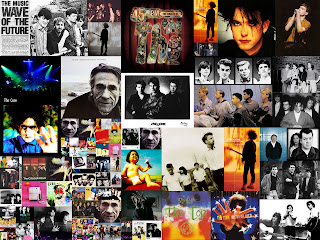 New Wave's older siblings, Punk and Power Pop, surfaced during the latter half of the 70's and helped ignite what was to become one of the biggest musical explosions of the last 20 years, certainly in terms of creativity and diversity. Disco and early electropop pioneers—namely Giorgio Moroder and Kraftwerk—made their mark on new wave as well. While disco revolutionized dance music, widespread backlash forced it into the underground by the dawn of the eighties, leaving new wave to keep dance music afloat and the airwaves and club scene bristling with unheard of energy.
New Wave's older siblings, Punk and Power Pop, surfaced during the latter half of the 70's and helped ignite what was to become one of the biggest musical explosions of the last 20 years, certainly in terms of creativity and diversity. Disco and early electropop pioneers—namely Giorgio Moroder and Kraftwerk—made their mark on new wave as well. While disco revolutionized dance music, widespread backlash forced it into the underground by the dawn of the eighties, leaving new wave to keep dance music afloat and the airwaves and club scene bristling with unheard of energy.New wave proved to be breathtaking in its scope—it was hard to perceive where it began and ended, both chronologically and musically. I would venture that new wave music occupied the era from 1978 to 1986, after which there was a notable decline offset by movements such as Industrial and Acid House (both seeds of Techno) and the great rise in college indie rock (alternative rock). Musically, new wave should not be pigeonholed or written off simply as "skinny ties," synthesizer geeks, new romantics, and pretentious, fashion-as-content bands. Certainly at the core of most new wave *was* an infectious dance beat or D.I.Y. energy, and more mainstream artists like Joe Jackson, Greg Kihn and rock veterans like David Bowie and The Kinks brushed the fringes of this musical tapestry. Movements like the more guitar-driven Power Pop often seemed to mesh virtually indistinguishably.
Movements and styles such as Synthpop (Depeche Mode, Yazoo, Human League, Soft Cell) and New Romantic (Ultravox, Visage, Classix Nouveaux, Spoons, Peter Godwin, early Talk Talk) were, to many, the defining styles of new wave. Gary Numan's "Cars," Soft Cell's stark electronic take on "Tainted Love," and The Human League's "Don't You Want Me" helped push this new futuristic synthesizer-driven sound into the US mainstream. New romanticism, on the other hand, never managed much of an impression in the US—it remained very much a European (and Canadian) movement. Despite the general inadequacy of pigeonholing, there were the other requisite, defining styles from the era: Goth (Siouxsie & The Banshees, The Sound, Specimen, Bauhaus), Postpunk (The Chills, Gang of Four, The Cure, Joy Division, Comsat Angels), Ska (Madness, The Specials, The English Beat, The Untouchables, Bad Manners), Rockabilly (Dave Edmunds, Stray Cats, Polecats, The Cramps), and Power Pop (The Vapors, The Producers, 20/20, The Records). And still that's only scratching the surface. Even Top 40 radio itself was fresher than it ever could hope to be. Hardly the same can be said today.
[bxA]
***

Thanks for visiting my blog. Good idea on New Wave. I was a fan before still will always be. I love the Cure and Tears for Fears. Though now I`m more into RNB/Blues I can never forget the songs of New Wave.
ReplyDelete